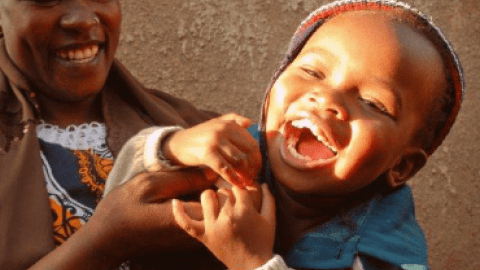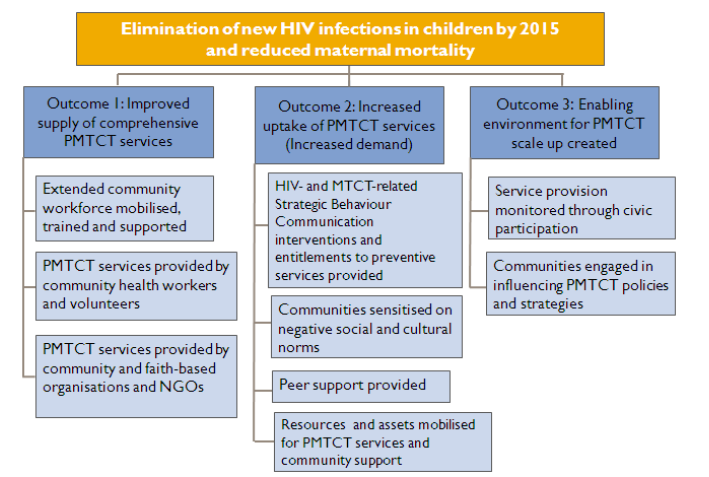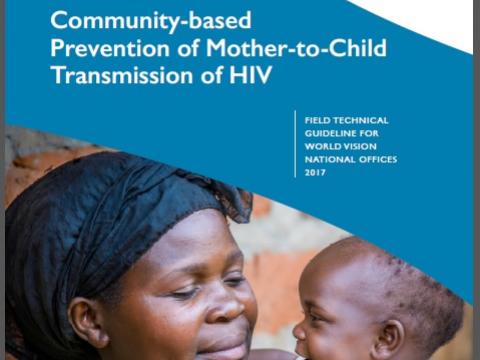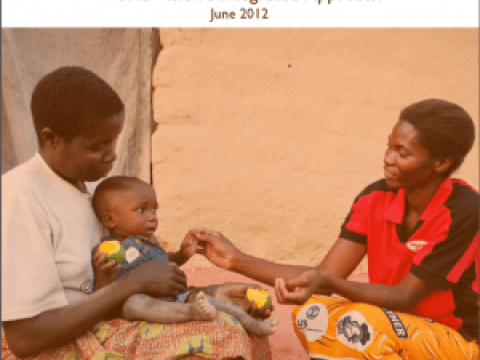
PMTCT Approach
For the first time, the elimination of mother-to-child transmission of HIV is considered a realistic public health goal and an important part of the campaign to achieve the United Nations Millennium Development Goals (MDGs) 4, 5 and 6. The prevention of mother-to-child transmission (PMTCT) of HIV has played an important role in this campaign and in ensuring increased maternal and child survival.
Continue reading for an overview of the PMTCT approach and World Vision's integrated community-PMTCT (c-PMTCT) approach, then download key resources for in-depth detail and support.
c-PMTCT: World Vision's Integrated Approach
What is PMTCT?
The four components of the comprehensive PMTCT programme endorsed by the World Health Organization (WHO) and UNICEF are:
- primary prevention of HIV among women of childbearing age
- prevention of unintended pregnancies among women living with HIV
- prevention of HIV transmission from a woman living with HIV to her infant
- provision of appropriate treatment, care and support to women living with HIV and their children and families.
These guidelines, updated by WHO in 2010, recommend prolonged use of antiretroviral drugs (ARVs) during pregnancy and recommend that mothers living with HIV, or their infants, take ARVs while breast-feeding up to 12 months to prevent HIV transmission. When implemented, these recommendations can reduce the risk of transmission from 35 per cent to less than 5 per cent in breast-feeding populations, and from 25 per cent to less than 2 per cen in non-breast-feeding populations.
How is PMTCT implemented?
This model uses a life-cycle approach for women and children. For each of the four components, there are both clinical and community-based interventions that ensure the continuum of prevention and treatment service from health facility to the community and to the individual mother and newborn, while focusing services on the well-being of the whole family. To eliminate mother-to-child transmission, all of the different stakeholders (including governments, international agencies and civil society) need to work closely together and must contribute to the four prongs laid out by UNAIDS's Global Plan, 'Countdown to Zero.'
What is unique to World Vision's c-PMTCT?
As an organization that works directly in the communities, World Vision sees its role in strengthening PMTCT on this level. Therefore, the organisation's focus is on community-PMTCT (c-PMTCT). Community-based interventions within each of the four ‘prongs’ of PMTCT are designed to increase community need (demand) for health services and commodities and to strengthen the quality of these services at the primary health-care (PHC) level. In addition, community institutions themselves are strengthened to advocate for the supply of services in accordance with international guidelines, and they are empowered to sustain the social mobilisation and the continuum of care for mothers and children within a family-based approach. c-PMTCT includes the early diagnosis of exposed infants and clinical referral for enrollment in CPT and ART to reduce preventable deaths of newborns and children under 5. This family-based approach ensures that male partners and other household cultural influencers are involved in the care and treatment of mother and child.
Key c-PMTCT activities:
Primary prevention of HIV
-
Introduce community-based life skills and behaviour change communications to prevent primary infections.
-
Engage in social mobilisation to reduce stigma and gender inequities and to engage boys, girls, women and men in their own health care
-
Integrate information and education on PMTCT into all education, health care and HIV and AIDS messaging and programming.
-
Increase the use of HIV counselling and testing (HCT) at all levels, with increased use of couples counselling and testing.
Prevention of unplanned pregnancies
-
Facilitate information and access at the community level to modern contraceptives to prevent unplanned pregnancy.
-
Promote the use of dual methods of contraception to include condoms to prevent transmission of HIV.
Prevention of HIV transmission from a woman to her infant
-
Facilitate access and promote regular attendance to antenatal care for pregnant women.
-
Promote opt-out/routine HIV counselling and testing (HCT) for pregnant women in antenatal care and for their male partners.
-
Provide home-based and community-based counselling on PMTCT for all pregnant women and their male partners, which includes: HIV testing, continued primary prevention during pregnancy and breast-feeding, male partner HCT, skilled birth attendance for delivery, postnatal care, exclusive breast-feeding, ART literacy, infant care and early infant diagnosis.
-
Strengthen and empower community leaders and civil society organisations to advocate at district and national levels for improved quality and decentralisation of PMTCT services to meet new WHO standards.
-
Improve the quality of comprehensive PMTCT services through training of primary and community health workers and volunteers on Ministry of Health national guidelines.
Provision of appropriate treatment, care and support for women living with HIV and their children
-
Establish formal community-facility linkages to strengthen a two-way referral system that improves uptake and follow-up services.
-
Promote and facilitate formal facility-to-community linkages to strengthen the supervision of community- and home-based care.
-
Facilitate and strengthen community outreach from primary-care facilities, including mobile HCT, enrolment in appropriate PMTCT services, defaulter tracing, tracing of mother-to-infant pairs, mothers’ support groups, early infant diagnosis, treatment support and home-based care.
-
Train community volunteers to provide home-based PMTCT follow-up and support services, including breast-feeding support, male-partner and family counselling, referral for early infant diagnosis, ART and CPT adherence support, and continued post-natal and infant care.
-
Through integrated programming, link HIV-positive mothers and infants to other services as necessary, including immunisations, family planning, water, sanitation, hygiene, food security, nutrition and economic development.
How will World Vision implement c-PMTCT?
World Vision will not develop a new programme model on c-PMTCT, but rather will use its compendium of existing health, HIV and infectious disease community programmes to increase demand and support for the uptake of PMTCT services in the community. Each World Vision national office will need to do its own analysis of their health and HIV programme models to identify channels of integration and potential gaps where support or partnership is needed. New programme elements will be developed to fill these gaps. We will not provide clinical PMTCT services, but World Vision will work with government health services and other clinical service providers to ensure comprehensive integration with effective linkages between the health facility and the community. For information of the existing World Vision programme models that will be used to achieve c-PMTCT goals, c-PMTCT: World Vision's Integrated Approach.
Where will c-PMTCT be implemented?
Seven countries—Democratic Republic of the Congo, Kenya, Malawi, Tanzania, Uganda, Zambia and Zimbabwe—have been chosen to focus technical and financial support in order to pilot the c-PMTCT approach. These priority countries have been chosen according to the following criteria: operating World Vision programmes, inclusion in the UNAIDS Global Planfor PMTCT, identification as one of UNAIDS top 20 HIV-prevalent spots, presence of generalised epidemics, and possession of the capacity and willingness to commit to the process.
What are the expected outcomes of c-PMTCT?
The following ‘objective tree’ shows World Vision’s expected outcomes when implementing the c-PMTCT process. It is important to emphasise that World Vision is not a service provider but will be working through the community to meet the desired goal and outcomes.


